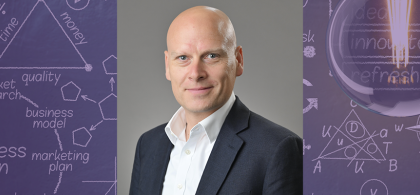
Well-being at work: why tackling tasks in the right order matters
Starting the day with the most onerous tasks, rather than the easiest, and shifting to easier ones later has a positive effect on employees' quality of life at work and overall engagement — that’s the key finding of an article co-authored by NEOMA’s Zhaodong (Alan) Qiu and five fellow researchers. The study also encourages managers to explain the importance of this sequencing to their employees, and to give them a measure of flexibility in how they organise their time.
How can you boost employee well-being and productivity by restructuring the work you give them? Numerous researchers have put forward various solutions in recent years, such as diversifying tasks, balancing high-pressure and low-pressure activities, and switching between interesting assignments and more routine duties.
This adaptation is not possible, however, in professions where the nature of the role, the clients or the deadlines dictate a strict framework. Even in contexts where flexibility is possible, the magnitude of the transformation acts as a deterrent: what company would willingly overhaul the workflow of its employees when it is hard to predict and measure the potential gains?
Employees feel more refreshed and relaxed at the end of the day
The recent study published by the six researchers presents an alternative solution: modifying the sequence of the daily tasks assigned to employees — akin to upscaling a factory’s output by reorganising the production line. The researchers back up their findings with field studies involving 392 staff members in two Chinese companies where workers have the freedom to fine-tune their personal workflows.
The key takeaway is this: employees who begin their day by tackling the toughest (high-effort) tasks first, prior to transitioning to lighter assignments, feel less tired and more relaxed at the end of the day. What’s more, they are more likely to go the extra mile to help colleagues, suggest improvements and come up with new strategies.
Developing an understanding of task sequencing
The researchers also observed that with the “toughest task first” approach, employees who naturally like to start tasks early and get ahead of deadlines feel that they make headway with their work. Conversely, colleagues who tend to ramp up their efforts closer to deadlines do not experience the same motivational uplift. .
This gives managers an additional tool to get the best out of their teams... without exhausting them! They are urged to develop an understanding of task sequencing instead of defaulting to the usual “Get the job done, and the rest is up to you” approach, and give colleagues the freedom to structure their days how they want. We should keep in mind, too, that a task’s difficulty is also determined by how crucial and time-sensitive it is.
Testing the Theory in Actual Workplaces
While previous studies have explored the same issue, they have mostly been based on laboratory experiments involving straightforward tasks lasting little more than 30 or 40 minutes. This research, by contrast, set out to remain true to practical realities encountered on the ground. The first field experiment involved 166 volunteer participants over the course of five working days within their company.
The second study used a different approach—an experience sampling method (ESM) survey conducted over two weeks among 226 employees, with their feedback combined with the perceptions of their supervisors. In addition, participants were tracked from morning to evening, and not just when making their initial choice between immediate intensity and a gradual increase in effort. In fact, the feeling of well-being at work rises and falls as the hours pass, ultimately moulding the memory of the day that will stay with us.
Finding the balance between the motivation to act and internal inertia
In an attempt to understand the advantages of the “harder first” approach, the researchers grounded their analysis in the theory of cognitive dynamics developed by the American psychologist Arie W. Kruglanski. This explains why and when an individual embarks on a task, based on the current level of their mental energy and cognitive resources.
The theory posits that a person’s ability to take action is rooted in the difference between an individual’s motivation (or potential driving force: PDF), which is influenced by factors such as the importance of the goal, available energy, probability of success and level of urgency; and the internal obstacles that hold them back (restraining force: RF), including cognitive fatigue, environmental distractions, lack of focus and the perception of having to make an excessive effort.
Why it's more exhausting to save the hardest for last
Our PDF declines mechanically over the course of a day: when we tackle a succession of tasks, our energy level drops slowly over time. But if we move from the most difficult task to the easiest, the RF also decreases, given that each subsequent activity requires less effort than the one before. On this basis, the PDF and RF decrease in sync. We are calmer, and more confident in our ability to wrap up the day’s tasks, which makes us feel we’re less tired and more relaxed by day’s end.
Conversely, employees who start with the simplest assignments see their RF rise, since each subsequent task becomes progressively more demanding. As the hours pass, they have to push themselves harder to maintain momentum. This inner struggle stirs a sense of doubt, procrastination, the temptation to cut corners and the urge to disengage. The day seems more exhausting, and generates more nervous tension.
It follows that a team can unlock greater productivity and enhance its sense of well-being simply by reordering its routine tasks. Still, this idea needs wider dissemination, and businesses and managers must now step up to take ownership of this powerful productivity lever.
Find out more
Chen Zhang, Zhaodong (Alan) Qiu, Helen H. Zhao, Mengxi Yang, Wansi Chen, Yuan Ma, Harnessing the Potential of Workday Design: The Sequencing of Task Difficulty and Its Implications for Workday Well-Being and Performance, Personnel Psychology, May 2025. https://doi.org/10.1111/peps.12685
Related news
Professor

QIU Zhaodong (Alan)
Zhaodong (Alan) Qiu is an Assistant Professor in the People and Organisations (P&O) department at NEOMA Business School. He earned his Ph.D. in Management from Tsinghua University. During his doctoral studies, he served as a visiting scholar at the Stephen M. Ross School of Business, University of M



